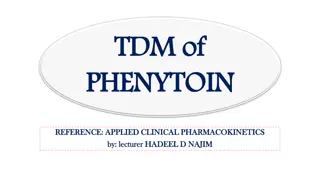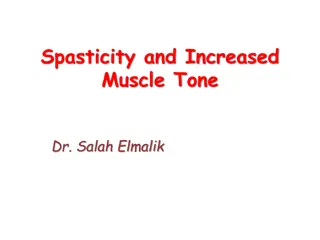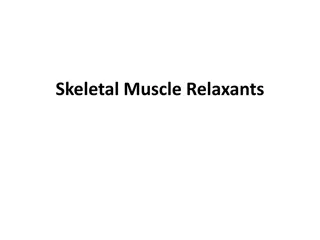Skeletal Muscle Relaxants: Classification, Pharmacokinetics, and Clinical Applications
Skeletal muscle relaxants encompass different types, including neuromuscular blockers, spasmolytic drugs, and peripherally-acting agents. They are classified based on mechanisms of action and play crucial roles in inducing skeletal muscle relaxation for various clinical applications. Understanding the pharmacokinetics, dynamics, and classifications of these relaxants is essential for their proper utilization in medical practice.
Download Presentation

Please find below an Image/Link to download the presentation.
The content on the website is provided AS IS for your information and personal use only. It may not be sold, licensed, or shared on other websites without obtaining consent from the author.If you encounter any issues during the download, it is possible that the publisher has removed the file from their server.
You are allowed to download the files provided on this website for personal or commercial use, subject to the condition that they are used lawfully. All files are the property of their respective owners.
The content on the website is provided AS IS for your information and personal use only. It may not be sold, licensed, or shared on other websites without obtaining consent from the author.
E N D
Presentation Transcript
Skeletal Muscle Relaxants Objectives: Identify classification of skeletal muscle relaxants. Describe the pharmacokinetics and dynamics of neuromuscular relaxants. Recognize the clinical application for neuromuscular blockers Know the different types of spasmolytic. Describe the pharmacokinetics and dynamics of spasmolytic drugs. Recognize the clinical application for spasmolytic drugs. Editing File Editing File Lecture in physiology. We recommend you to study NEUROMUSCLAR JUNCTION Important Notes Extra
Skeletal Muscle Relaxants WhatareSkeletal Muscle Relaxants? Drugs used to induce skeletal muscles relaxation. Classification of Skeletal Muscle Relaxants: They are classified according to the mechanism of action into: Skeletal muscle relaxants Peripherally acting Spasmolytic Neuromuscular blockers or motor end plate blockers Centrally acting Direct acting Non- Depolarizing blockers Baclofen (act on spinal cord) depolarizing blockers (competetive) Dantrolene Diazepam Atracurium Succinylcholine (act on spinl cord) Mivacurium Pancuronium Vecuronium D-tubocurarine *Prototype is the first drug discovered in a particular class. Related drugs are compared with it. or Curare (Prototype*)
Peripheral Acting Drugs: Mainly and widely used Neuromuscular Blockers (Peripheral Acting) Act by blocking neuromuscular junction or motor end plate leading to skeletal muscle relaxation. M.O.A Classifi According to the mechanism of Action: cation 1-Competitive (Non-depolarizing) Blockers 2-Depolarizing Blockers Compete with Ach for the nicotinic receptors present in postjunctional membrane of neuromuscular junction or motor end plate. No depolarization of postjunctional membrane (non depolarizing). ! combine with nicotinic receptors in postjunctional membrane of neuromuscular junction initial depolarization of motor end plate muscle twitching persistent depolarization SKM relaxation M.O.A According to the duration of action: Type of inhibition Long acting: D-tubocurarine(Prototype)(Curare not used anymore) Pancuronium Intermediate acting: Atracurium Vecuronium Short acting: Mivacurium (Ester) Drugs Succinylcholine (Suxamethonium) Variation of duration depends on metabolism Polar compound Inactive orally, taken parentally Don t cross Blood brain barrier (No central acting) Don t cross placenta (Can be used with pregnant women) Metabolism by either liver or kidney EXCEPT : Mivacurium (by Acetyl cholinesterase) Atracurium (Spontaneous degradation in blood) Metabolism by liver means intermediate duration. Metabolism by kidney means long duration Pseudocholinesterase works at blood circulation Acetyl cholinesterase works at NMJ P.K Degradation in blood due differences in pH between drug and blood
Cont.. 1-Skeletal muscle relaxation. 2-They produce different effects on CVS 3-Some release histamine and produce hypotension; o d-Tubocurarine (Severe release) o Atracurium (Moderate release) o Mivacurium (Mild release) 4-Others produce tachycardia ( H.R); oPancuronium (No release of Histamine) Pharmacodynamics The increase in H.R by Pancuronium is due to stimulation of Sympathetic system - Neuromuscular control convulsion electroshock therapy in psychotic patients. Relieve of tetanus and epileptic convulsion. As adjuvant in general anesthesia to induce muscle relaxation Facilitate endotracheal intubation Orthopedic surgery Uses of Blockers There are diseases and drugs that modify the effects of Neuromuscular blockers which are: Diseases: Myasthenia Gravis increases the response to those drugs Drugs: As Aminoglycosides (e.g. Streptomycin), Magnesium Sulphate and General anesthesia can potentiate or enhance the effects of NM blockers Modify the effects of NM blockers Diseases caused by Drugs: Malignant Hyperthermia the rare bizarre inherited condition of having a body temperature greatly above normal. occurs upon administration of drugs as: general anesthesia e.g. halothane neuromuscular blockers e.g. succinylcholine Mechanism of the disease: Inability to bind calcium by sarcoplasmic reticulum in some patients due to genetic defect . Ca release intense muscle spasm Hyperthermia Treatment : Dantrolene
It just prevents the effect of Ach but doesnt produce an action They have common suffix curium or curonium Competitive (Non- depolarizing) Blockers : Drug D-tubocurarine Vecuroniu m Mivacuriu m Pancuronium Atracurium Fast onset of action Has the shortest duration (15 mins) of all NM blockers Metabolized by Pseudo- cholinesteras e Chemically related to Atracurium Intermediate duration (30 mins) Eliminated by non enzymatic chemical degradation in plasma (Hydrolysis at body pH) As potent as curare More potent than tubocurarin e (6 times) Metabolize d mainly by the liver and excreted in Bile Intermediat e duration More potent than Curare (6 times) Excreted by kidney 80% Long duration of action Long Duration (1- 2h) Eliminated mainly by kidney 60%, liver 40% P.K Hypertension, Tachycardia due to increase Norepinephrin e release from adrenergic nerve endings Anticholinergic action (Block parasympathet ic effects) Block muscarinic receptors in SA node of heart Not used clinically due to its side effects. Histamine releaser leading to: Bronchospasm Hypotension Tachycardia (Reflex for hypotension) Has few side effects: No Histamine release No Tachycardia (No Ganglionic block nor anticholiner gic effects) Liberates Histamine causing transient hypotension. Bronchospas m Pretreatment may prevent those side effects Transient Hypotension due to Histamine release ADRS More safer derivatives are now available . Given with renal failure patients. Drug of choice in liver and kidney failure patients Uses - - -
Cont.. Liver produces enzymes. Malnutrition causes reduction in amino acids which essential in the synthesis of proteins Longer duration in liver diseases or Genetic Cholinesteras e deficiency or malnutrition Contraindication Asthmatic patients because of release of Histamine Patients with coronary diseases - Depolarizing NM Blockers: Twitching means individual contraction of muscle fibers Succinylcholine (Suxamethonium) Drug Fast onset of action (1 min.). Short duration of action (5-10 min.). Metabolized by pseudo-cholinesterase in plasma Half life is prolonged in Neonates (Low enzymes) Elderly (Liver function declined due to aging) Pseudo-cholinesterase deficiency (liver disease or malnutrition or genetic cholinesterase deficiency). Contraindications Glaucoma Patient with cardiac diseases. P.K Skeletal muscles: twitching relaxation (Usually used before surgery) Hyperkalemia: Cardiac arrest. CVS: arrhythmia Eye: intraocular pressure (due to contraction of extra-ocular muscle) Pharmacodyna mics Hyperkalemia causing cardiac arrest CVS arrhythmia Intraocular pressure contraindicated in glaucoma Can produce malignant hyperthermia May cause succinylcholine apnea due to deficiency of pseudo-cholinesterase.(affects intercostal and diaghram muscles) GIT: increased intra-gastric pressure leads to regurgitation of gastric. ADRS
Extra Explanations Mechanism of action of NM Blockers: Extra explanation from 436: Normally in the neuromuscular junction, the acetylcholine will attach with the acetyl choline receptors (in skeletal muscle the receptors are nicotinic receptors type 1 after that a lot of changes will happen and then the muscle will contract. The Neuromuscular blockers basically will block the nicotinic receptors so the acetyl choline can not bind with the receptors and produce its action (muscle contraction) and if the muscle will not contract it will relax . Mechanism of action of Depolarizing Blockers: Don t skip this part! They fool Ach receptors in the MEP by attaching to them and stimulating the same effect as the Ach(acetylcholine) so they initiate the contractions of muscles fasciculation (twitching) by opening the Na++ sodium voltage channels. in the beginning. but after the sodium inside the muscle is used. the depolarizing blocker will still be attached to the Ach receptors. which will prevent repolarization. this is called hyperpolarization so no more contractions will occur. e.g of depolarization NMB is (succinylcholine) They are agonist drugs https://www.youtube.com/watch?v=1YkMzGXq2Z8 note : watch first minute only MEP: muscular end point
Spasmolytic Reduce muscle spasm in spastic states Centrally acting ,Example: Baclofen GABA (gamma-amino butyric acid GABA )* agonist. Acts on spinal cord, Example: Diazepam (Benzodiazepines): facilitate GABA* action on CNS M.O.A Direct action on skeletal muscles, Example: Dantrolene They reduce muscle spasm in spastic static state produced by neurological disorders such as: spinal cord injury Cerebral stroke Cerebral palsy Note: they also work as sedimentation drugs. Uses Dantrolene Acts directly on skeletal muscles. It interferes with the release of calcium from its stores in skeletal muscles (sarcoplasmic reticulum). It inhibits excitation-contraction coupling in the muscle fiber. M.OA Orally, IV, (t = 8 - 9 h). P.K Spastic states Malignant hyperthermia (The drug of choice) Uses Extra picture:
Summary Side effects Duration Long 1-2 h Long 1-2 h Short 30 min. This table was taken from Prof.Hanan s lecture Drug Notes Hypotension # Renal failure Tubocurari ne Pancuroniu # Renal failure Tachycardia m Atracurium Transient hypotensi on Histamine release Few side effects Spontaneous degradation Used in liver and kidney failure # Liver failure Vecuronium Short 40 min. Mivacurium Short 15 min. Similar to atracuriu m Metabolized by pseudocholine sterase # Choline esterase deficiency # CVS Diseases # Glaucoma # Liver disease Succinyl choline Short 10 min. Hyperkalemi a Arrhythmia Increase IOP Mnemonics: From 436 Dantrolene Diazepam Baclofen (Diaze) dizzy (zepam) spasm , (Act on (CNS acting) spinal cord) (natrilene) (Act dirctly) (Da) (fen) (Baclo) (CNS)
Questions MCQs: 1-Depolarization NMB are an ..drug? A)Antagonist. B)Agoist. C)Physiological. D)All of them. 2-muscle relaxant might cause ? A)spasm. B)hyperthermia. C)hyperkalemia. D)b and c. 3-Which of the following acts directly on the muscle: A)Dantrolene. B)Diazepam. C)Baclofen. D)Vecuronuim. 4-Which of the following is a depolarizing blocker? A)Atracurium. B)D-tubocuranine. C)Succinylcholine. D)Baclofen. 5-Patientswith coronary diseases must avoid which Relaxant ? A) Vecuronium B) Pancuronium C) Mivacurium D) Atracurium 6-Which one of the following Relaxants has the shortest Duration of Action ? A)d-Tubocurarine B)Atracurium C)Mivacurium D)Vecuronium 7-Vecuronium Metabolized Mainly By A)Liver. B)Kidney. C)Spontaneous Hydrolysis at body pH. D)Pseudo-Cholinestrase. Answers: 2-D 7-A 3-A 1-B 5-B 4-C 6-C
Cont.. SAQ: 1)Malignant hyperthermia occurs as a bizarre ADR of some muscle relaxant name two of them ? 1-halothane 2-neuromuscular blockers e.g. succinylcholine 2)Why using muscle relaxant during caesarean surgery doesn t affect the baby? Because the drug doesn t cross into the placenta. 3) Why using muscle relaxant during caesarean surgery doesn t affect Uterus? Because it doesn t affect smooth muscle.
It is not hard, you just made it to the end! Team Leaders: Yazeed Alharbi & Aseel Badukhon Thanks for those who worked on this lecture: Abdullah abdurahman al-asseri Abdulhakim Alonaiq Bader Altamimi Fayez Ghiyath Aldarsouni Maan Abdulrahman Shukr Mohammed alnajeim Omar Alsuhaibani Sultan Omar Almalki Yazeed abdullah alkhayyal Ahmed Lateef Alanzy Adel Alorainy References: Team436 Doctors notes and slides @Pharma4370 pharmacology437@gmail.com























